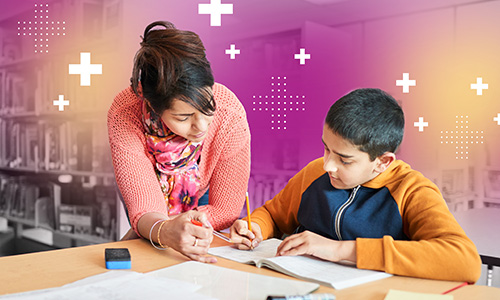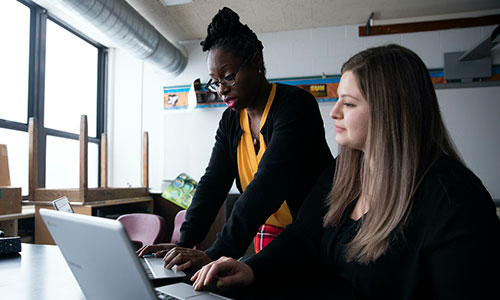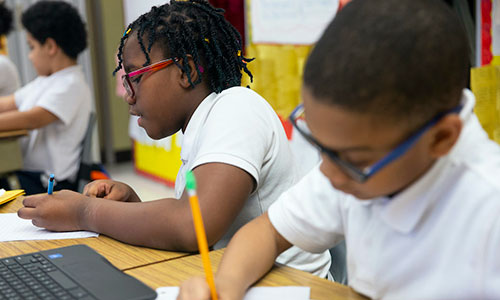
It was my first year teaching, and I was getting my classroom ready for school when my new principal dropped off my name tag. “Please wear this every day,” he said. “And good luck this year!”
I looked down at the tag he had placed on my desk. It read Special Education Teacher, with my name below. I gasped. “Oh, no, no, no! I cannot wear this!” I picked up the name tag and ran after him. I explained that I needed a new one, that “special education” needed to change because it’s a loaded, vague term that can do more harm than good. He didn’t understand.
I never did wear my name tag that year. It never got changed either.
Why the term “special education” falls short—and what to say instead
Kids have been taught that it’s not a good thing to be in “special education,” that they’re somehow less than, inferior to their peers. “Special” has come to mean “not good enough” for many of them, and they’re not alone; the negative connotation of the word “special” has been growing for years.
A disability is a mismatch between a person and their environment.
It isn’t exactly clear when “special needs” or “special education” became popular. It may have been as far back as the 1960s when the Special Olympics began. Or it may have happened when the term “handicapped” started getting eliminated from legal language with changes to laws such as Public Law 94-142, the Education for All Handicapped Children Act of 1975, which changed to Individuals with Disabilities Education Act (IDEA) in 1990.
Language used to describe people with disabilities has continued to evolve this century, too. In October of 2010, President Obama signed legislation requiring the federal government to replace the term “mental retardation” with “intellectual disability.” The measure is known as Rosa’s Law and is named after Rosa Marcellino, a Maryland girl with Down syndrome who championed the change.
Updates in language at the federal level are critical for justice for people with disabilities. Language changes—and the reasons behind them—can take a long time to trickle down, however, and changing the connotation of a term can be especially challenging. A 2016 study by Morton Ann Gernsbacher et al. proves this point. In their article “‘Special needs’ is an ineffective euphemism,” they document their research of the term “special needs” and explain that “persons are viewed more negatively when described as having special needs than when described as having a disability.” They also say that “special needs conjures up more associations with developmental disabilities (such as intellectual disability) whereas disability is associated with a more inclusive set of disabilities.” An association with developmental disabilities shouldn’t be a problem in and of itself, but data shows bias against people with developmental disabilities is grossly prevalent.
I agree with Gernsbacher et al. that “special needs” is ineffective. It is imprecise. A disability is a mismatch between a person and their environment, so the term “disability” is not just much more accurate, but it also helps us understand how to reach a student better. “Disability” helps us see that a student and their environment simply aren’t compatible, and once we know that, it’s easier to focus on a productive approach: how to alter the environment. That is what accessibility is all about. Accessibility is the correction of that mismatch.
Be kind, get curious, and focus on the facts
Words matter, and it is important to use respectful language when communicating about people with disabilities. Just because two people have the same disability does not mean they will feel the same way about their disability or how their disability should be described. Here are some things to strive for as you consider the language you use when talking about students with disabilities.
How to show kindness
For many people, the term “special needs” feels offensive. As someone with a learning disability who went through school in “special education” and on an individualized education plan (IEP), I prefer and believe in owning the term “disability.” Therefore, when I describe my disability, I use the terms “learning disability” and “dyslexia.” Maybe someone else with dyslexia prefers different language, however. Disabilities cross cultures, genders, age, race, and beliefs, so the language can never be one-size-fits-all. Preferences will vary.
[L]isten to how your students identify and would like to be addressed.
Conventions will change, too. When I started my career in academics, for example, I was taught to always use person-first language. This approach conveys that a person is not defined by their disability. However, as I quickly learned in my more real-world application of accessibility, the use of person-first language is debated within the disability community. Some people prefer the use of “identity-first language.” Identity-first language, as defined in “Ask a self-advocate: The pros and cons of person-first and identity-first language,” “leads with a person’s diagnosis, such as being a disabled person.” I have also learned that person-first language was originally promoted mainly by the non-disabled community. As well-intentioned as this may have been, we were not given ownership of ourselves, our disability, and how we describe ourselves. Ownership is important. So is agency.
If you’re a teacher, I encourage you to listen to how your students identify and would like to be addressed. While some may be too young to express this information, know that most disabled persons, myself included, do not want to be referred to as having “special needs,” and they definitely don’t want it announced that they are in “special education.” I never felt I learned differently from my classmates, and I certainly didn’t feel “special” (nor did I want to).
Please know that it’s ok to say “disability” or “disabled,” but even better is asking the person you’re referring to what they prefer. Honoring someone’s personal preference is a simple way to show a great deal of kindness. Before I speak at an event where I’ll be discussing disabilities and accessibility, I often identify the language I will use and why. That makes it easier for people to understand not just my personal preferences, but the fact that everyone will have their own personal preferences. Not sure what someone prefers? Cue the curiosity.
Ways to be curious
If a person feels comfortable with you and they disclose their disability to you, ask them how they prefer you to refer to their disability (or, potentially, not refer to it). Do they prefer person-first or identify-first language?
Another way to get curious, which takes the burden off the disabled person, is to read materials by people with disabilities, like the self-advocacy article I mentioned earlier. Find out what you don’t know, and if you’re reading a personal narrative, notice the way the author references themselves in their writing. Not every person with a disability will want to talk about their disability. It has taken me a long time to talk openly about my disability because of painful past experiences; for a long time, I was very selective about whom I shared my story with. Disabilities are deeply personal and deserve respect, no matter the type. Using the internet to your advantage so you can learn more will help you educate yourself without pushing a friend, colleague, or student to say more than they feel comfortable with.
Why facts matter
As humans, we want to do the right thing and sometimes our well-intended choice to use terms such as “physically or mentally challenged,” “exceptional,” “learning difference,” or “special needs” comes across as condescending and offensive. Why? Because these terms seem to be tiptoeing around what is a daily reality for some of us. So name the disability: Blind. Deaf. Learning disabled. Or use generic terms that don’t try so hard to flatter, like “physical or cognitive disability.” There’s nothing wrong with people with disabilities, and trying to mask reality with flowery language can make it seem like there is.
Language for describing people without disabilities can be just as challenging. For example, “able bodied” is sometimes used to describe people without a disability, but for some in the disability community, this implies we lack use of our bodies. The preferred terms and phrases are “not disabled,” “non-disabled,” “does not have a disability,” or “people without disabilities.” Avoid terms such as “normal,” too, that imply people with disabilities are strange or abnormal. We’re not. With 26% of adults in the US living with a disability, we’re hardly unusual.
Allies are amazing
I understand language is difficult at times. Trust me. I’m dyslexic. But even just trying to do the right thing can go a long way. If you mess up, that’s okay. Learn and move forward. We’re all just human, and we all want to feel seen, heard, and respected.







